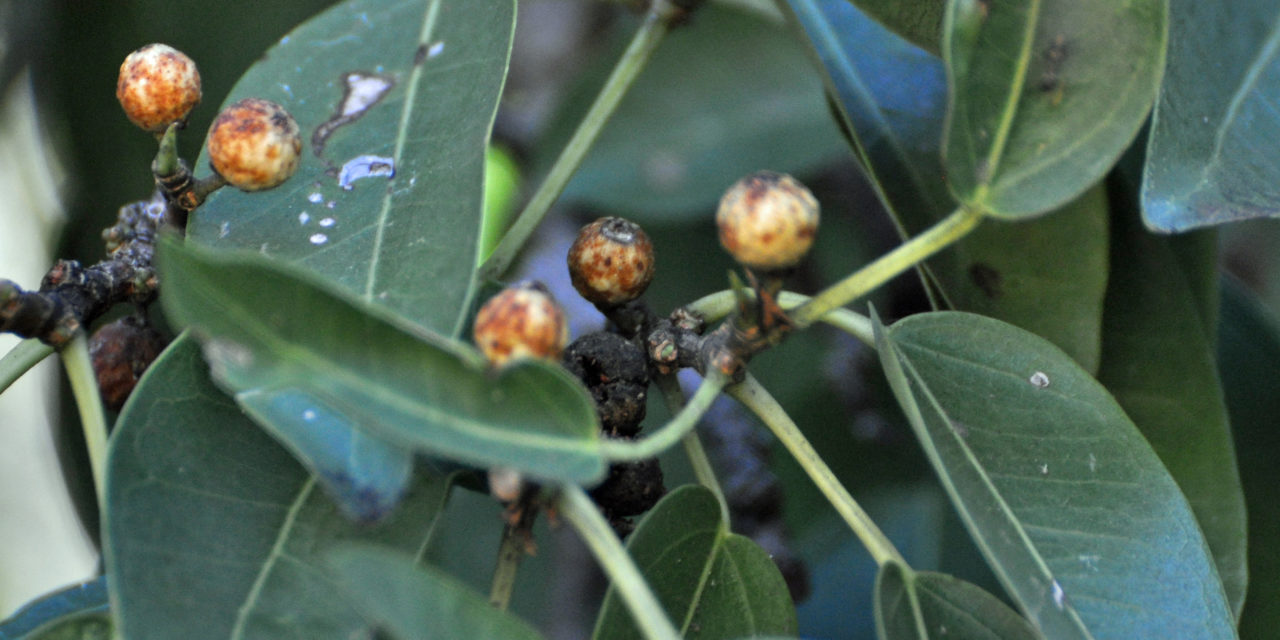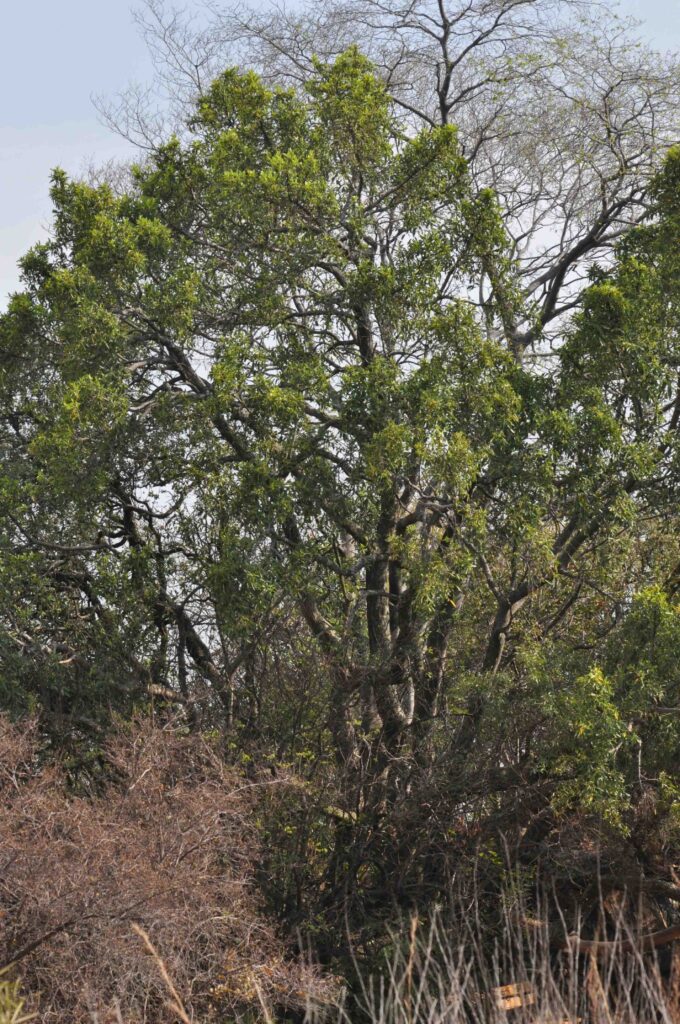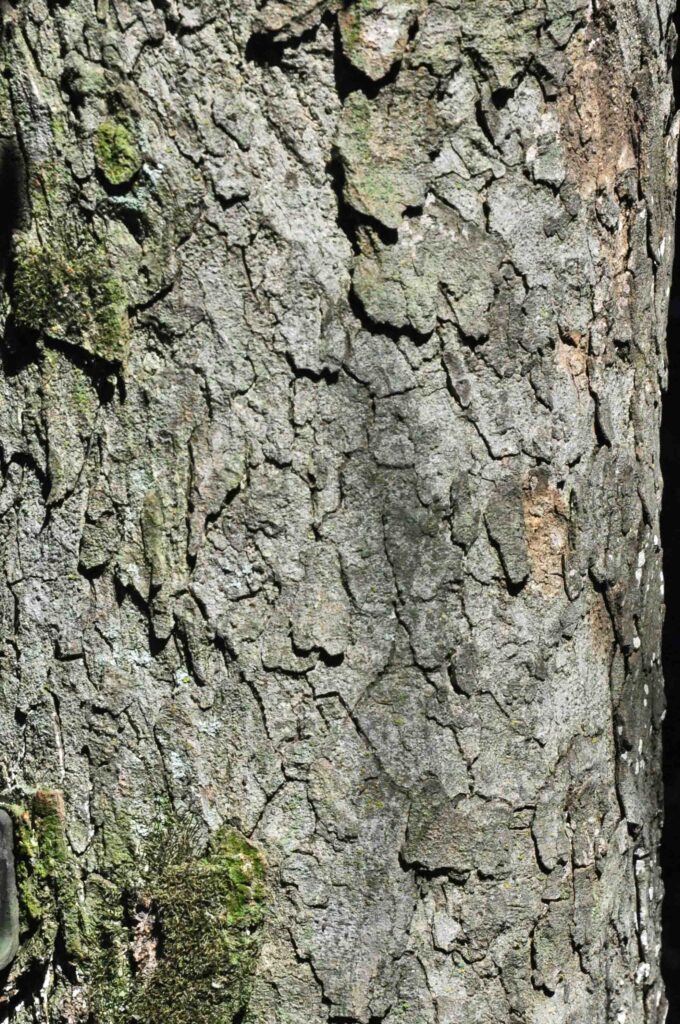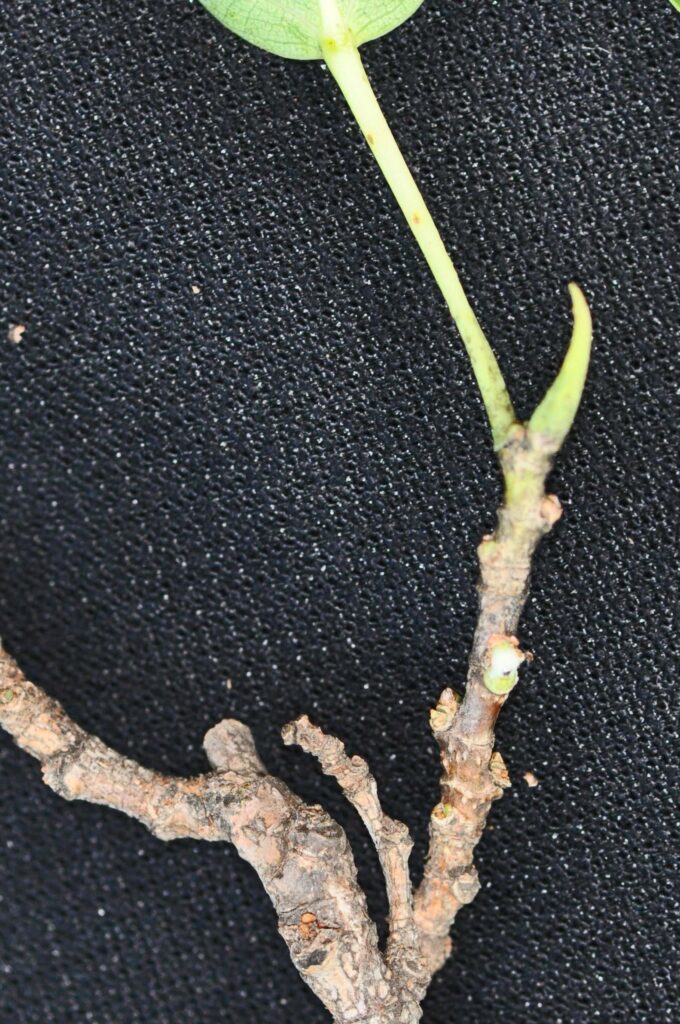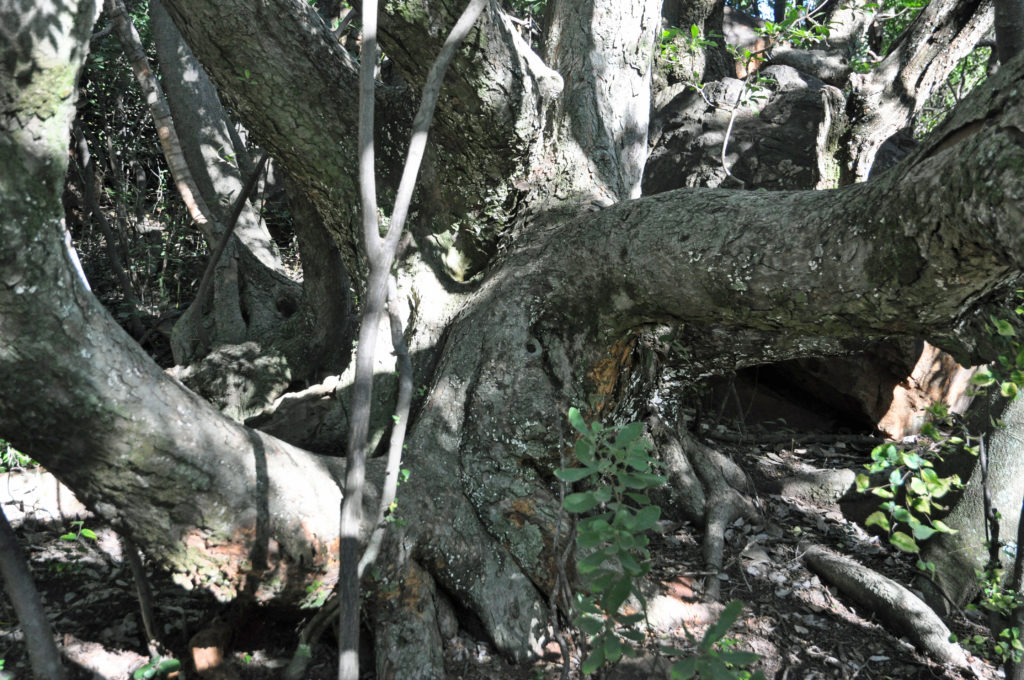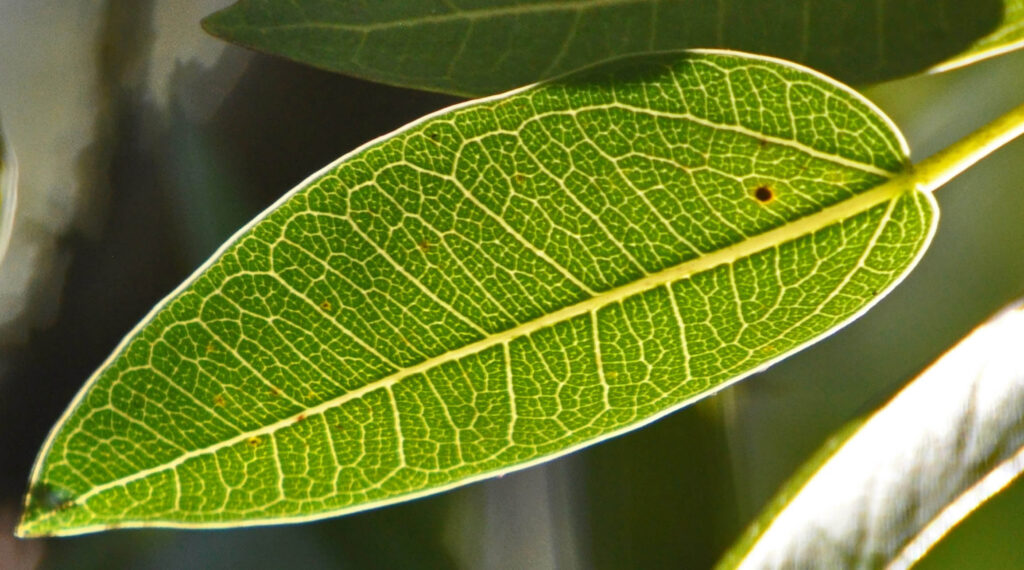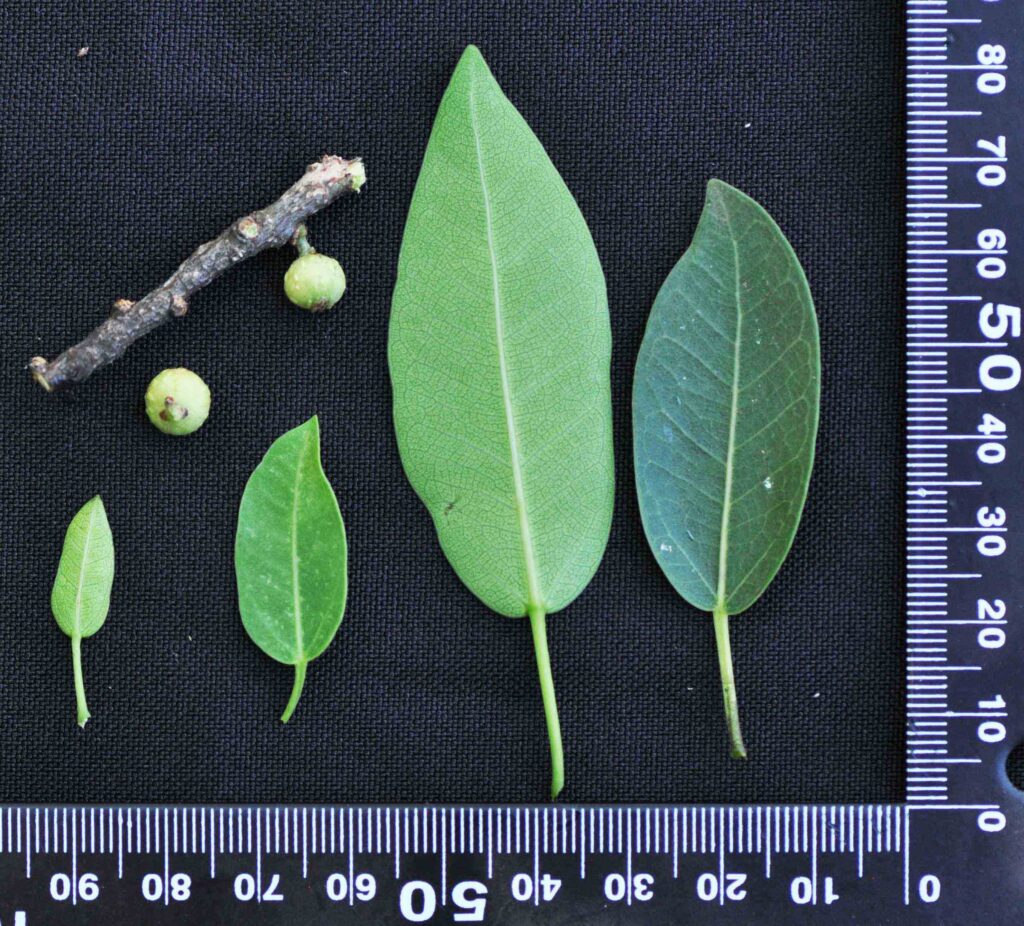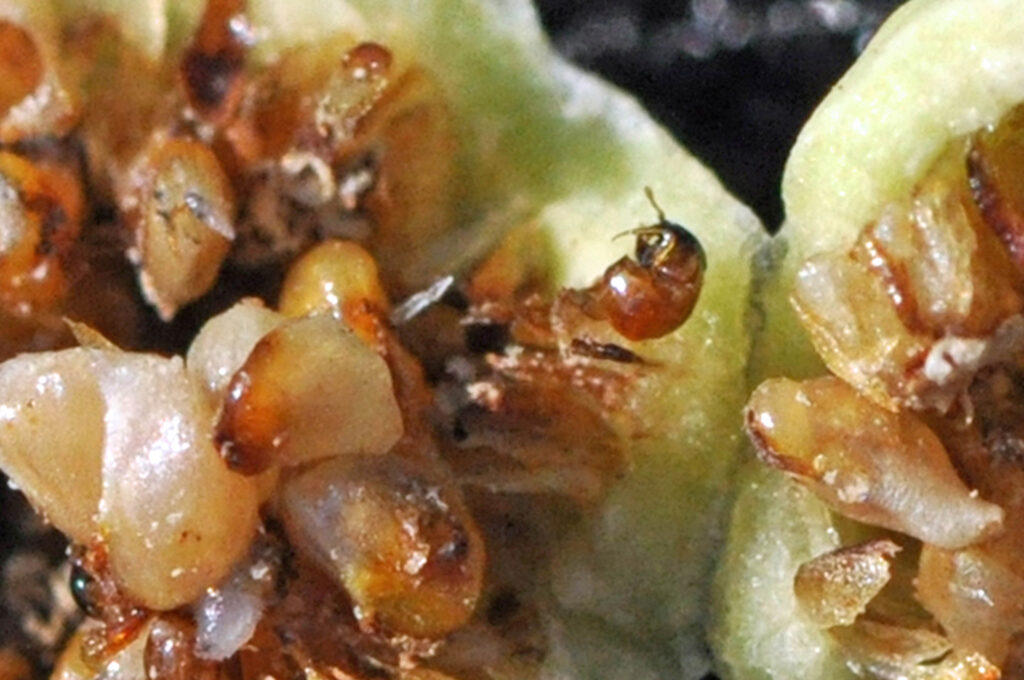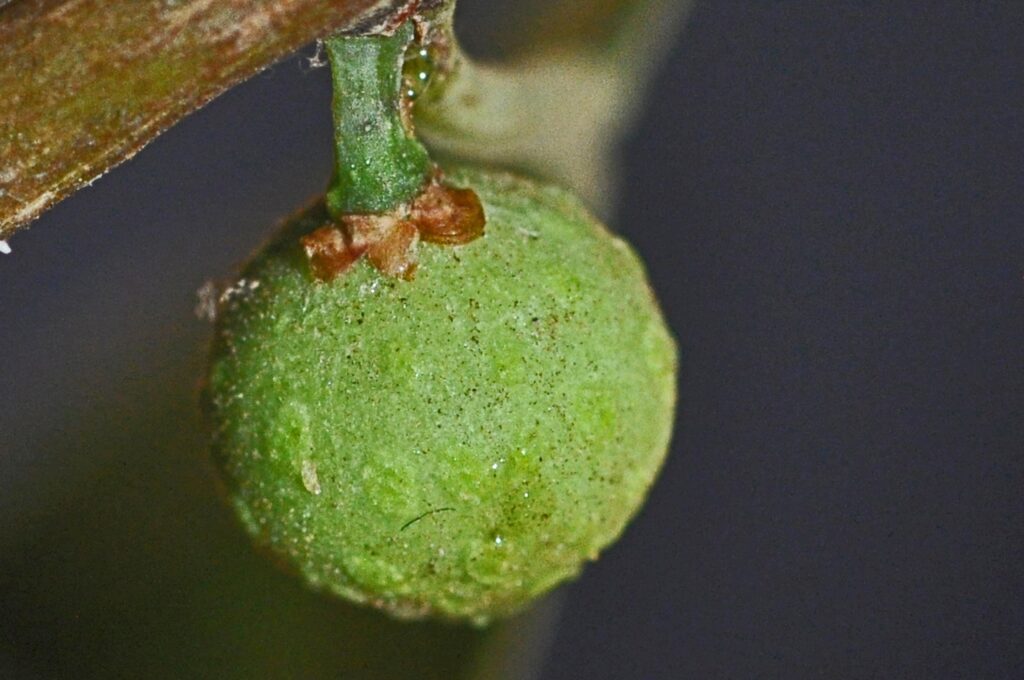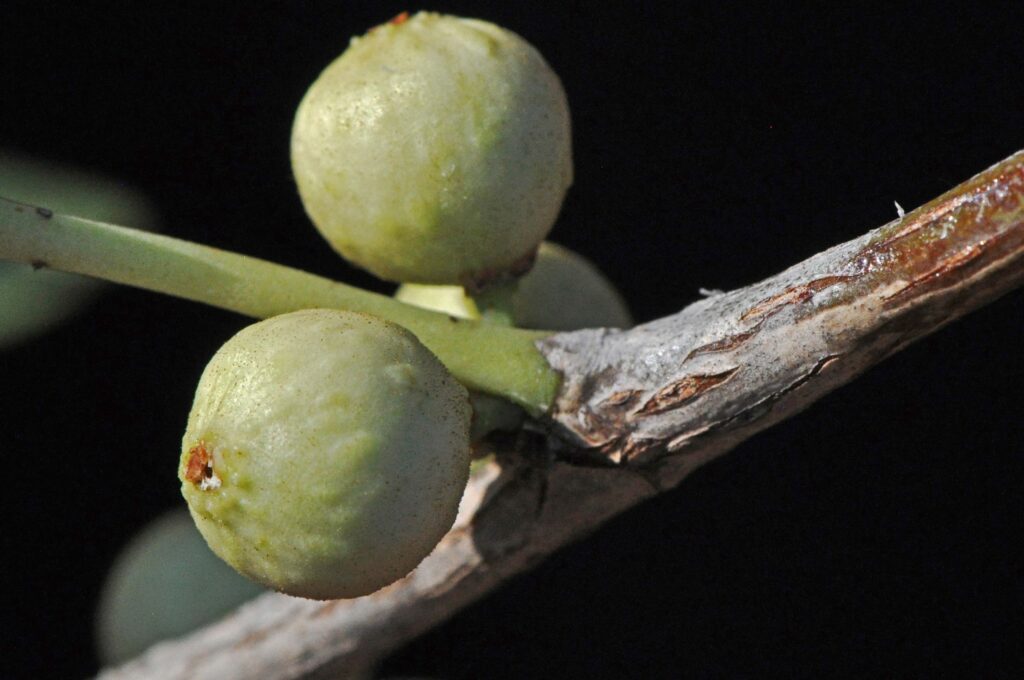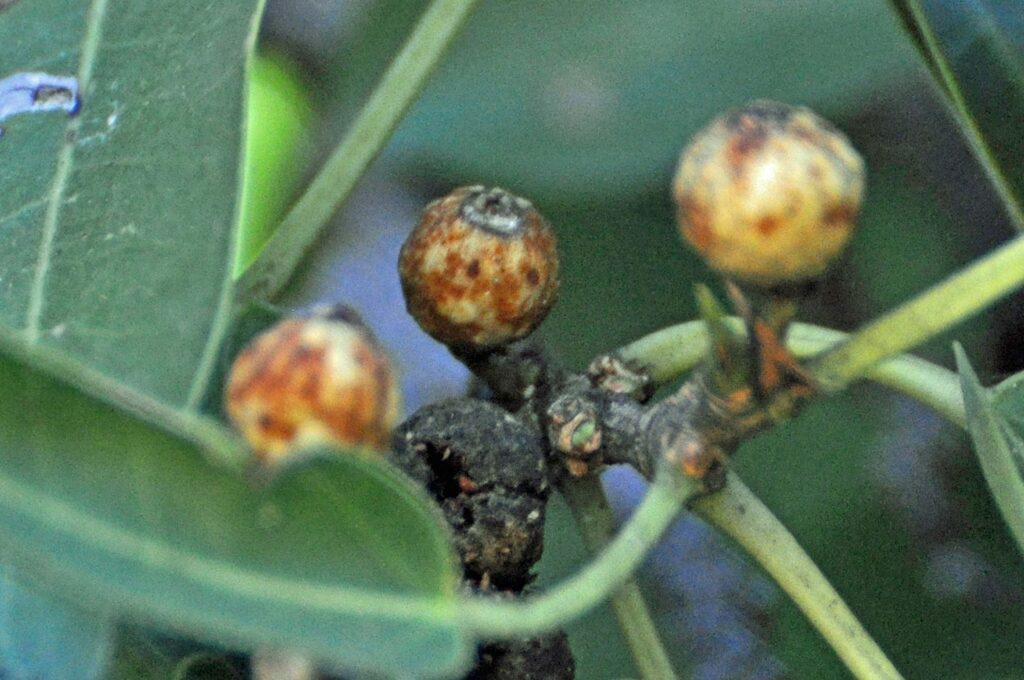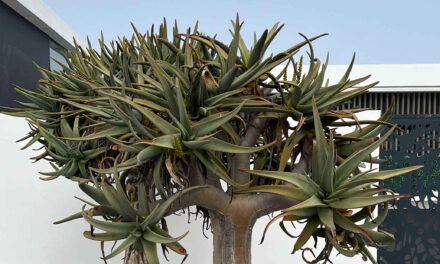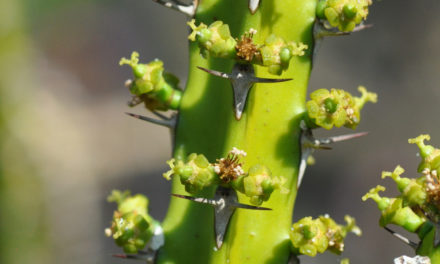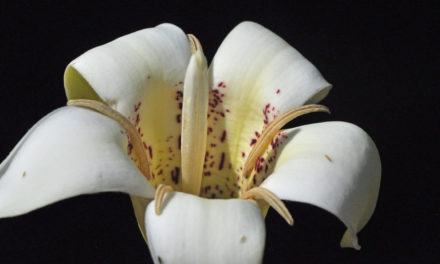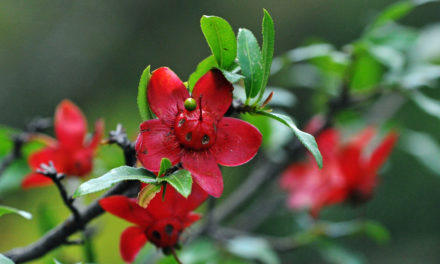General Info – Summary
This dry area survival, monoecious Tree is up to 9m+ high (shorter in arid areas) with non-toxic milky latex. It may be a rock-splitter. Exposed, light, flattened roots are distinctive. Simple, hairless Leaves are entire and have a basal pair of longer veins. Tiny, unisexual Flowers are contained in a syconium and pollinated by the female wasp (Platyscapa desertorum). The small ripe speckled Fruit is an edible fig.
Description
Ficus cordata subsp. cordata
Previous Names: Ficus cordata var. fleckii, Ficus cordata var. marlothii, Ficus glaucophylla, Ficus rupium, Ficus tristis, Ficus welwitschii, Urostigma cordatum.
SA Tree No. 51.
Common names: (Afr) Melkboom, Melkhoud, Melkhoutboom, Namakwa-rotsvy, Namakwavy, Namakwa-vy. (Eng) Namaqua Fig, Namaqua Rock Fig.
Family: Moraceae (fig or mulberry family). Trees are evergreen and have milky or watery latex present. The simple Leaves are alternate or opposite and 3-veined from near the possibly lobed base. They are usually entire, and all leaves have stipules. Plants are monoecious or dioecious and flowers are unisexual. The Perianth of indigenous species contain sepals but no petals. Male flowers have up to 6 stamens. Female flowers are inconspicuous and lack staminodes. The superior or inferior Ovary has 1 locule with 1 ovule and 2 styles are often present. The compound usually fleshy Fruit contains various Seeds. The family has 37 genera and about 1 100 species.
Name derivation: Ficus – named by Carl Linnaeus in 1753 – Latin name for fig. cordata – heart shaped: referring to the leaves of some plants. The genus Ficus has 36+ species in southern Africa and 25 in South Africa.
Conservation: National Status: L C (Least Concern). Assessment: 2005 (J.E. Burrows and J.E. Victor).
Tree
In dry areas, this Tree is often a small plant with a whitish, tortuous Trunk. The trunk may be pale and twisty in dry areas and here the branches are coiled. It may also be a rock-splitter. In favourable conditions, it may become a medium sized Tree (photo 297) up to 18m high, with an upright crown spreading up to 15m across. Bark is initially pale grey and smooth but becomes rougher with age (photo 38). Branchlets may be yellowish and slightly hairy. Leaf scars are visible on young branches (photo 43). The flattened Roots are whitish and distinctive when running down steep rock slopes (photo 37). Non-toxic Milky sap is released when plant parts are damaged.
- 297. 2017/10//02. Pretoria NBG. Photo: David Becking.
- 38. 2017/03/21. Pretoria NBG. Photo: David Becking.
- 43. 2017/03/21. Pretoria NBG. Photo: David Becking.
- 37. 2017/03/21. Pretoria NBG. Photo: David Becking.
Leaves
The simple, hairless and ovate (egg-shaped), cordate (heart shaped) or oblong Leaves are up to 15,5 x 5,5cm but usually smaller (photo 713). They are dark green above and lighter below. The Apex tapers and may end in a sharp point. The Base is rounded (photo 40), square, or cordate (heart shaped). All veins are clearly visible when the leaf is viewed against a strong light (photo 40). There are up to 9 visible main lateral Veins on either side of the Midrib. The basal pair is prominent and emerges at about 45 degrees to the midrib and links to the other side veins. These veins loop together prior to reaching the margin (photo 40). The Margin is entire (with a continuous margin, not in any way indented). The Petiole (leaf base) may be grooved on the upper surface (photo 713) and is up to 4cm long. Stipules (basal appendage of the petiole) wrap around the terminal bud but are caducous (an organ or part of which is easily detached and shed early – photo 43 – under Tree).
- 40. 2017/03/21. Pretoria NBG. Photo: David Becking.
- 713. 2017/10/31. Pretoria NBG. Photo: David Becking.
Flowers
Individual flowers are minute. Figs possess an amazingly arranged flower head called a Syconium. Essentially this consists of a Receptacle (is that expanded tip of the flower stalk from which the floral parts develop. It expands greatly in the Compositae / Asteraceae and Ficus). In figs, the perimeter of the receptacle substantially increases in size and folds over forming the fig shape. The hollow fig ends with a tiny opening called an Ostiole, which is covered with scales making exit impossible and entrance difficult for wasps (photo 908). Only the female pollinating wasps (here Platyscapa desertorum) attempts to do so and they usually injure themselves in the process. Around the inner boundary of the hollow receptacle of the fig, a large collection of extremely small flowers is located. These tiny flowers are unisexual. In the Male flowers, up to 6 overlapping Perianth (the 2 floral envelopes considered together; a collective term for the calyx and corolla) lobes and one or 2 Stamens are present. The ovary is absent or vestigial (imperfectly developed, non-functional relic from the past. When present it is usually smaller). In the Female flower, there is a free Ovary with 1 or 2 styles. The Stigma is usually oblong. There are no stamens and usually fewer perianth lobes. Look carefully at cross section of a fig – photo 909 showing a developing wasp emerging from a female fig flower.
- 909. 2017/11/14. Pretoria NBG. Photo: David Becking.
- 48. 2019/09/27. Pretoria NBG. Photo: David Becking.
- 908. 2017/11/14. Pretoria NBG. Photo: David Becking.
Fruit
The stalked Figs (photo 48) are small, about 1cm wide and monoecious (having both male and female reproductive organs on the same plant). Figs are axillary or on terminal branches. The specific Female wasp for this fig enters the fig with her pollen sacks laden with pollen and, incidentally, pollinates those female fig flowers with longish styles. These long styles prevent the wasp from laying eggs here. The wasp targets the flowers with short styles and lays a single egg in each one. These female flowers react producing a gall, nourishing the developing larvae, which eventually pupate and become adults. The robust Male wasps develop first, fertilize the young Female wasps and then burrow through the wall of the fig allowing oxygen in. The Female wasps then, unintentionally, load pollen from the male flowers before escaping from the fig and make their way to another fig, of the same species, and so continue the life cycle. This is an excellent example of a mutualistic relationship that occurs between the fig tree and the wasp – in which both benefit. Nearly a week after the wasps have left, the figs with their fertilized seeds, ripen and develop into a small, speckled Fruit that is up to 12mm wide. This ripening process is due to the oxygen induced Ethylene production. Ethylene is a small flammable hydrocarbon gas that is odourless and has a sweet musky odour. This gas is involved in the ripening of the fruit including causing the fruit to change colour, texture and soften. It is used commercially to ripen fruits like tomatoes, bananas and pears. The small, ripe fig fruit is brown to yellowish (photo 39) and up to 7mm in diameter. Figs develop in leaf axils (the upper angle between a lateral organ, such as a leaf, and the stem that bears it) on terminal branches and may be connected with a short stalk (photo 48 & photo 713 under Leaves). The usually paired fruit changes from yellow to purple when ripe (photo 39).
- 39. 2019/03/21. Pretoria NBG. Photo: David Becking.
Distribution & Ecology
This tree is a survivor in arid rocky conditions. Trees are located in the Western Cape e.g. Langeberg mountains and the Cedarberg, Northern Cape including Namaqualand (an arid region of South Africa e.g., Augrabies falls and extending more than 1 000km northwards along the west coast) into Namibia e.g., Fish River Canyon and near Windhoek. From here, trees extend slightly into south-western Angola. These trees also occur in Botswana. They often occur in mountainous and rocky areas including cliff-faces and granite domes – up to an altitude of 1 500m. The larva of the Common Fig-tree Blue butterfly (Myrina silenus) feeds on these leaves and on leaves of many other fig trees. This butterfly has the longest and heaviest hind wing tails of any SA butterfly, and it is found in the arid west and the moist south and east of SA. Birds, including the short-billed tit-babbler, eat the fruit. When pollinating wasps are absent, the figs will abort and land on the ground in large numbers.
Ethnobotany
No indigenous figs are poisonous, and these figs are edible. Cord is extractable from the bark. Stools may be made out of the trunk. The whitish trunk, roots and grey foliage helps with tree identification. This is a great shade tree and much appreciated in very dry areas.
References
Burrows, J.E. & Victor, J.E. 2005. Ficus cordata Thunb. subsp. cordata. National Assessment: Red List of South African Plants version 2020.1. Accessed on 2023/06/05.
Coates Palgrave, M. 2002. Keith Coates Palgrave Trees of Southern Africa, edn 3. Struik, Cape Town.
Lawrence, G. H. M, 1951. Taxonomy of Vascular Plants, The Macmillan Company, New York. Tenth Printing 1965.
Palmer, E. & Pitman, N. 1972. Trees of southern Africa, Balkema, Amsterdam, Cape Town.
van Wyk, B. & van Wyk, P. 1997 Field guide to Trees of Southern Africa, Struik, Cape Town.
Woodhall, S. 2020. Field Guide to Butterflies of South Africa, edn 2. Donnelley, RR, China.
http://wikivisually.com/wiki/Ficus_cordata

